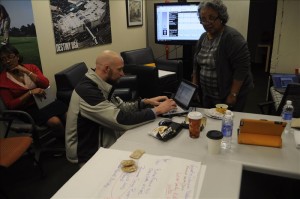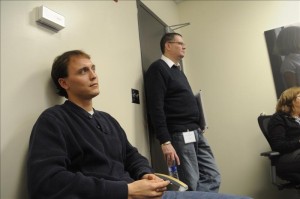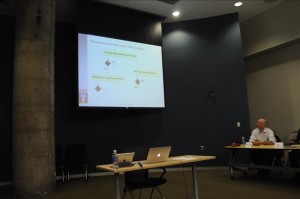Law students from the New York State Science and Technology Law Center at Syracuse University College of Law participated in a Pre-Seed Workshop sponsored by Launch New York and hosted by MedTech and CenterState CEO at the Tech Garden in Syracuse October 18th and 25th. Laura Prestia, a PhD student at Upstate Medical University, who is taking the Center’s Technology Transfers Law class, participated as an “idea champion”, the entrepreneur or inventor exploring the commercialization potential of a new product. In Prestia’s case, the product is a biomarker for fetal alcohol syndrome developed by Steven L Youngentob, PhD., whose lab she works in at Upstate.
Other NYS STLC members participating were: Justin Burgess, a third-year law student and Senior Research Associate Brian Becker, a second-year law student and Research Associate, and Associate Director Molly Zimmermann. The Pre-Seed Workshops, developed by Judy Albers and Mark Wilson, condense the issues to be solved by any successful entrepreneur into a series of sessions designed to orient the potential CEO to those issues and potential tools to solve them. In this respect, the Pre-Seed Workshops are excellent models for Technology Commercialization Law Students and complement the analysis structure of the research reports completed by the NYS STLC for new technologies.
Pre-Seed Workshops are an intense but rewarding two-day experience. For the uninitiated, an overview of the Pre-Seed Workshop experience follows. Most Pre-Seed Workshop participants are referred from a university technology transfer office or an economic development organization. Teams are built to support the idea champion, and include a business “coach”, an MBA student, an attorney with IP or startup business experience, a tech transfer officer, and an experienced member of the business community. The work is divided into a series of break-out sessions where teams cover components investors will require answers to and which are essential to successful commercialization. Topics include:
A) Clearly defining and characterizing the technology.
B) Determining the market(s) that it makes most sense to target, including choosing one to begin with.
C) Defining the “pain” or problem that the technology is designed to solve is subject of a session.
D) Determining the competition and why the new product can be expected to out-compete other options. Many innovators can become so focused on their own technology that they forget to research the landscape. Investors do not have the same attachment to these ideas will demand the new product has a competitive edge over the status quo. In addition, having a solution to a problem is only worthwhile if it is also cost effective, significantly easier to produce or use, safer, or more reliable. The team creates a comparison matrix listing competing products and their features to provide a visual representation of how the new product is better than the existing products.
E) Identifying the potential users of the new product, and how it is relevant to each. Teams develop a “value proposition” statement that explicitly lays out the various types of users of the product and the specific values or benefits each user stands to gain.
F) Establishing a value proposition and defining a business model to explain how the proposed business will operate. Teams design a supply chain diagram that illustrates how the product gets from manufacturing/production to the specified end user. The expected profit-per-unit is estimated factoring in estimated facilities and equipment needs. Burgess felt this portion was especially helpful on his team, explaining, “[the idea champion] had done some product testing through several iterations and had briefly looked at the competitive landscape, but did not really know where she needed to move next. We [the team] provided the suggestion of a value added reseller she could use for one of her target markets that would simplify her sales cycle.”

Syracuse University J.D. student Justin Burgess and idea champion Vicki Brackens make some changes in a final presentation slide show.
The final break out session is the assessment of revenue potential. At this stage the idea champion is able to look at a target market, estimate expenses and apprize the size of the opportunity. Teams are advised to keep the math simple, the recommended formula for market size in dollars is to multiply the number of potential buyers per year by the number of units per buyer per year and then by the product price. An easy way to guess for products entering an established market is to find a market research report and multiply it by a percentage that represents a realistic market share that can be captured.
At the end of the first day, homework is assigned for idea champions to complete before the next week’s workshop, This includes the production of a slide deck – template provided by the Pre-Seed organizers – to “pitch” their idea to a panel of experts the following week. “Alumni” of previous Pre-Seed Workshops wrap up the day with a presentation about the status of their efforts to commercialize their products.
The next week, the workshop commenced with a “football clinic,” the Pre-Seed Workshop’s way of addressing the technology and IP issues. The football is a metaphor for the technology and the product and the intellectual property. There is also a self-assessment survey to help idea champions evaluate whether they are a good fit for an entrepreneurial career.
The final breakout sessions include building a management team; addressing the eventual organizational structure and specific positions necessary for the development of the product. The next session further explored the technological status of the proposed product. Teams looked at where the product development was at the present time and where it needed to be for a functioning business. A path was outlined that listed necessary tasks as well as an expected timeline. Teams illustrate this with a Gantt Chart, a horizontal bar chart used to illustrate a project schedule, that includes past accomplishments and highlights key activities and milestones going forward.
The final break out session was a culmination of everything that had been done up to that point, a summary assessment of the product that answers the key question, is the idea worth pursuing? A specific Pre-Seed Filter is used to show the relative strength and weakness of each component from the technology to the team and the readiness of the product. This was followed by a industry presentation and information about Launch New York, a sponsor of the workshop.

Syracuse University J.D. student Brian Becker listens to a run through before the final presentation.
A panel of industry experts sat by to provide feedback to each idea champion after their pitch. The panel was: Seed Capital Fund of CNY Executive Director and Upstate Venture CEO Nasir Ali, Brian McIlroy, Healthcare Commercial Development Leader in Healthcare at GE IdeaWorks, Launch NY CEO John Seman, and Josh Stack, attorney and advisor in resilience, biomimicry & sustainability at Northeast Green Building Consulting, LLC. After each pitch the panel was given the opportunity to ask questions and then give feedback.
Burgess observed, “By the end of the second day, I think that the idea champions had a clear view of what thhe needed to do to tackle each of the three market entry points, and what was needed to move forward in terms of being diligent in searching for competitive IP.” When asked about his time spent in the Pre-Seed Workshop Burgess said, “I think this crash course solidified several central factors necessary for a startup and filled out areas where I was either unfamiliar or only had a very superficial understanding. What became apparent rather quickly was the necessity of having a significant market demand for the product, preferably one that is unmet. Making sure you can clearly identify what your product is, what your advantage is, what the pain point is (the problem being solved), and how you can address this need to be second nature to any entrepreneur.”

The final slide of the Pre-Seed workshop lays out potential paths for idea champions to follow.
Both Becker and Burgess thought the process made good use of the skills they’ve learned working with the NYS STLC. “We didn’t focus as much on the IP aspect as was the normal practice in the clinic, but we did make [the idea champion] aware of issues with relying on coders who are not part of the founders group and that she should have some sort of contractual understanding in place relating to the work for hire status of the programmers building the software,” explained Burgess.
“I would recommend the Pre-Seed Workshop to anyone interested in learning more about what it takes to prepare a business for venture capital funding,” added Becker.
For those interested, there are several Pre-Seed Workshops hosted across New York throughout the year. For more information visit the Pre-Seed Workshop website.
